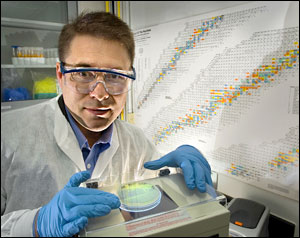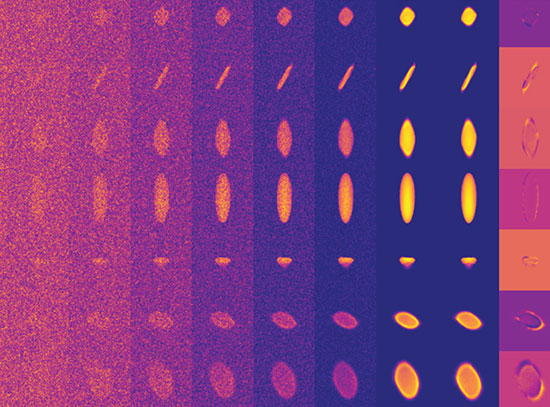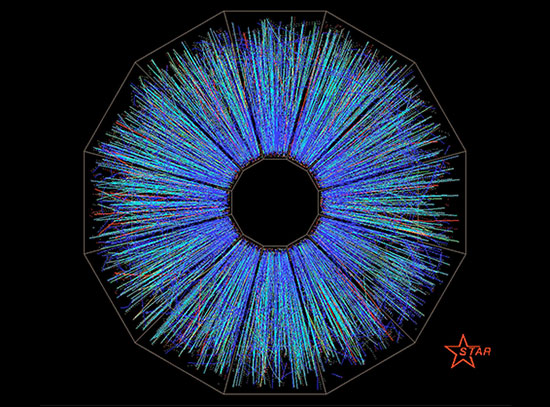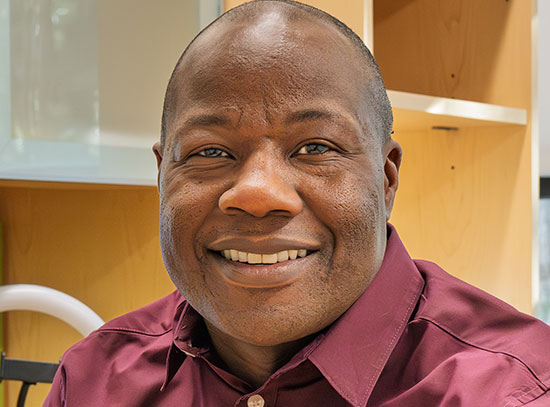Battelle Honors Scott Bronson as Brookhaven Lab's 'Inventor of the Year'
April 5, 2007
UPTON, NY - Scott Bronson, an educational programs administrator at the U.S. Department of Energy's (DOE) Brookhaven National Laboratory, will be honored as Brookhaven's "Inventor of the Year" by Battelle, a global science and technology company that develops and commercializes technology and manages five DOE laboratories. Battelle and Stony Brook University comprise Brookhaven Science Associates, the company that manages Brookhaven Lab.
Bronson holds eleven copyrights for science education kits he developed while working at Brookhaven Lab. WARD'S Natural Science of Rochester, NY, licensed the kits and is currently marketing them. Focusing on biology, engineering and environmental chemistry, the kits are used as hands-on learning tools in the classroom for middle school, high school and college students.
Bronson will be honored at Battelle's annual recognition program in Columbus, Ohio, on April 27, along with inventors from Battelle and from the other laboratories it manages.
"In many cases, the kits I designed were based on the work of Brookhaven scientists, who gave me their full cooperation in developing them," Bronson said."It is very enjoyable and rewarding to work with such talented and innovative people."
Biology
Brookhaven scientist F. William Studier helped to develop a kit that involves the use of the T7 bacterial virus, which forms the basis of the T7 expression system, developed and patented at Brookhaven in the 1980s and 1990s and used worldwide by academia and industry to produce specific proteins within bacterial cells. Using the T7 kit, students can safely learn about viruses.
With the tools in a protein extraction and purification kit, students can learn techniques that scientists use at Brookhaven's National Synchrotron Light Source to study biological materials. Students can also learn a simple method to analyze DNA. Two additional biology kits aid students in learning about gene transfer applications and DNA amplification - the repeated copying of a piece of DNA.
Environmental Chemistry
Two of Bronson's kits are based on a green-chemistry process invented by Brookhaven Lab scientists Cleveland Dodge and A.J. Francis. Using the kits, students can safely extract iron, a model used for a contaminant, from soil using citric acid, and they can use harmless bacteria to remove iron from solution, a process called bioremediation. Another kit, which Bronson designed with the aid of Stony Brook University researchers Mirza Beg and Aaron Celestian, shows students how zeolites, common materials within the Earth's crust, play an important role in cleaning up toxic metals and radionuclides from wastewater.
Engineering
Another kit allows students to build a Maglev train, a vehicle that floats over a fixed track, supported and driven by magnetic fields. Brookhaven researchers Gordon Danby and James Powell invented the concept of the Maglev train in the 1960s. Brookhaven Lab holds a Maglev contest for middle school students annually, coordinated by Brookhaven's Melvyn Morris, an educational programs administrator who helped Bronson with the kit design.
Designed with the help of Brookhaven Lab engineer Martin Woodle, two model bridge-building kits provide instructions and materials for students to build model bridges from either basswood or soda straws. Building up to ten bridges with each kit, students learn about the physics and engineering of bridge construction. Also, the kits help prepare students for the annual International Model Bridge Contest. Brookhaven Lab sponsors a regional model bridge contest for high school students and sends the two top winners to the international competition.
Scott Bronson's career in science started as a James Simons Summer Research Fellow at Stony Brook University, where he joined other academically talented high school students in hands-on research. Bronson earned bachelor's degrees in both molecular biology and marine biology from the Florida Institute of Technology in 1994, then joined Cold Spring Harbor Laboratory as a research technician. In 1997, he began working as an education coordinator at the laboratory's DNA Learning Center, and, in 2004, he earned a master's degree in science education from Long Island University's C.W. Post College. From 2000-2004, he was also a course instructor at the Watson School of Biological Sciences at Cold Spring Harbor Laboratory. He joined Brookhaven Lab in 2004.
2007-10613 | INT/EXT | Newsroom










